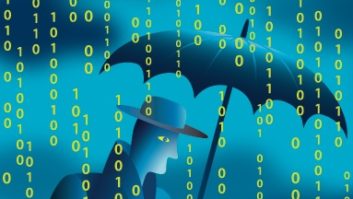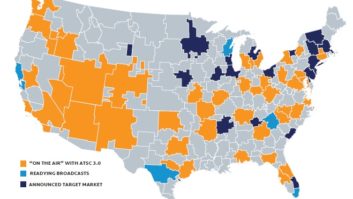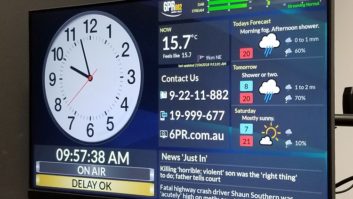(click thumbnail)
Apps, from left: Audio Tool, EchoLink, RadarScope and SPLnFFT.

Apps for the Radio Engineer
Great article (“Engineer, Apply Thyself,” July 13). I appreciate the time Laura Mir took to get together that bunch of apps.
Here is one you might look at. It is called Audio Tool by Performance Audio. It has a decibel meter and converts your phone into a mic. Really neat if you are doing sound and need a quick talkback. There are other features including an audio atlas, especially helpful when the boss needs an explanation of what you are really doing.
Randall F. Miller Jr.
Broadcast Computer Technician
Commonwealth Media Services
Harrisburg, Pa.
Ham and Mocha
For virtual network computing there are several apps. I use Mocha VNC Lite; I know some people use VNC Viewer by RealVNC. It’s helpful to log in to our Burk AutoPilot computer and check on sites or troubleshoot problems as needed.
There is also EchoLink by Synergenics, for licensed hams. I noticed Ham Helper and Echolink allow you to log in to other EchoLink repeaters around the world and talk to people.
For those of us who have to drive long distances to our transmitter sites, there is an app called GasBuddy. It finds my location and tells me where the closest gas is, or I can sort it by cheapest gas.
Amanda Alexander, CBT
Chief Engineer
Crawford Broadcasting
Denver
Weather Is Fun
Laura, it was a pleasant surprise to see your iPhone apps article. I’ve recently returned to the world of radio broadcast engineering after a hiatus; during that time, I’ve become an iPhone user and always thought of the wonderful applications the device would serve to the broadcast engineer.
Two apps I really enjoy, as they pertain to weather:
RadarScope by Base Velocity: A great weather radar app for keeping track of precipitation wet or icy, and dangerous storms. Shows your location on the radar. The weather geek can also purchase supplementary information from AllisonHouse for even greater information and details.
Weather Alert USA by Softpeas: Another great weather app; it provides current weather information and more importantly pushes National Weather Service alerts to the phone. Great for an engineer who would like to get the “heads up” before the storm arrives. Can be configured in “silent mode,” allowing tired engineers to get a good nights rest. It is highly configurable and can be used as a troubleshooting diagnostic for EAS alerts.
Mike Friedman
Richmond, Va.
App for Audio Metering
One my go-to tools is SPLnFFT, an audio metering app for iOS by Fabien Lefebvre. It combines real-time spectral analysis, multidimensional amplitude measurement and data export with an easy-to-use UI and a nice price.
In the same issue, you published Curt Yengst’s “Audio Software on the Cheap.” One of my preferred DAWs is Fast Edit, which is indeed fast, inexpensive and thankfully lacks the crowded UI and feature bloat of many similar products.
Oliver A. Masciarotte
Principal
Seneschal
San Francisco
CAP Delay? No Problem
Unlike some of the sentiments reported by Leslie Stimson about the rolled-back EAS CAP compliance deadline, I have no complaint with having installed equipment within the confines of the old September deadline.
First, a summer thunderstorm took out one of my units necessitating it be replaced. So I actually bought replacement Endecs for my entire cluster before the rush and was able to take delivery within a week.
Second, the ability to receive email reports from the new digital Endecs whenever they’ve handled an event means I have continuous proof of their proper operation and station compliance. I can even keep track of the Endecs that are not colocated under the same roof.
Third, when changes need to be made, I can do so for all of the units in my cluster from the comfort of my office desk.
And finally, I disagree that the November test, combined with setting up for CAP compliance, was going to be a problem requiring a further delay in the rollout of the new boxes. It was more important to get the new hardware out there installed with levels adjusted for reliable operation, easy to do before the November nationwide EAN test, than to worry about the final form of the CAP network. That can be phased in over time as long as the new hardware is already in place.
If anything, the new features of devices like the Sage Digital Endec have made it easier to set up for and monitor the results of the November test. I could have emails with MP3 audio files from all of my stations waiting in my in box immediately after the test. How neat is that?
Ira A. Wilner
Monadnock Radio Group
SagaCommunications
Keene, N.H.
The author is a contributor to Radio World.
Forgetting What’s Important
Regarding Buc Fitch’s blog post about emergency planning, “If and When It Gets Really Bad”
: I was reminded of a previous outfit for which I worked. I was involved in planning contingencies for whatever disaster might wipe out the studios, containing five FM stations. We called it a Business Recovery Plan, or BRP.
I noted that a large portion of our listeners and clients were line-of-sight to a particular tall building. This structure is on an area of land somewhat raised about the surrounding river valleys. So I suggested situating our emergency studio, or at least a transmitter, in the building, with our antennas on top of it.
Upper-level management was furious and rudely shunned me. Why? In addition to five FMs, the firm owned a cellphone company. The building I had suggested as a BRP site was owned by the owner of a rival cellphone company.
Epilogue: About a year ago, the owner of that tall building sold off their cellphone business.
Paul Sagi
Kuala Lumpur, Malaysia











